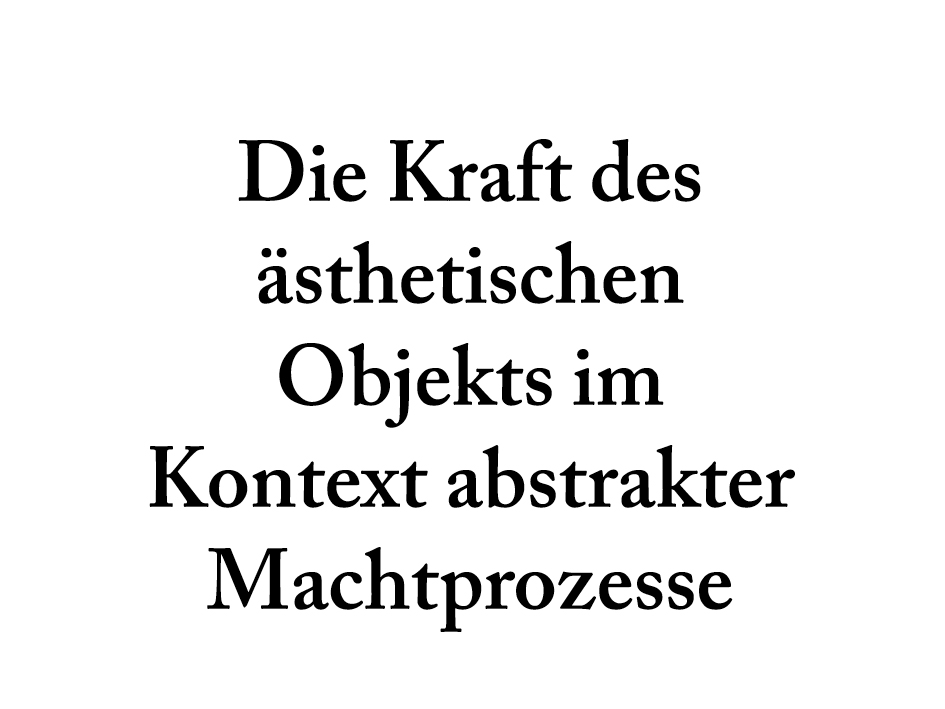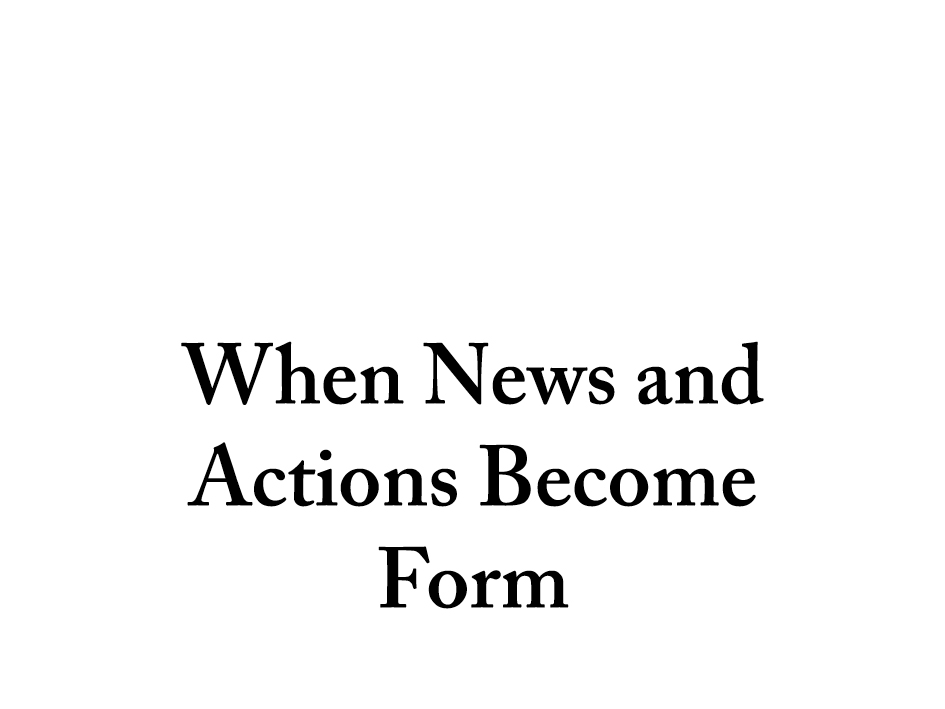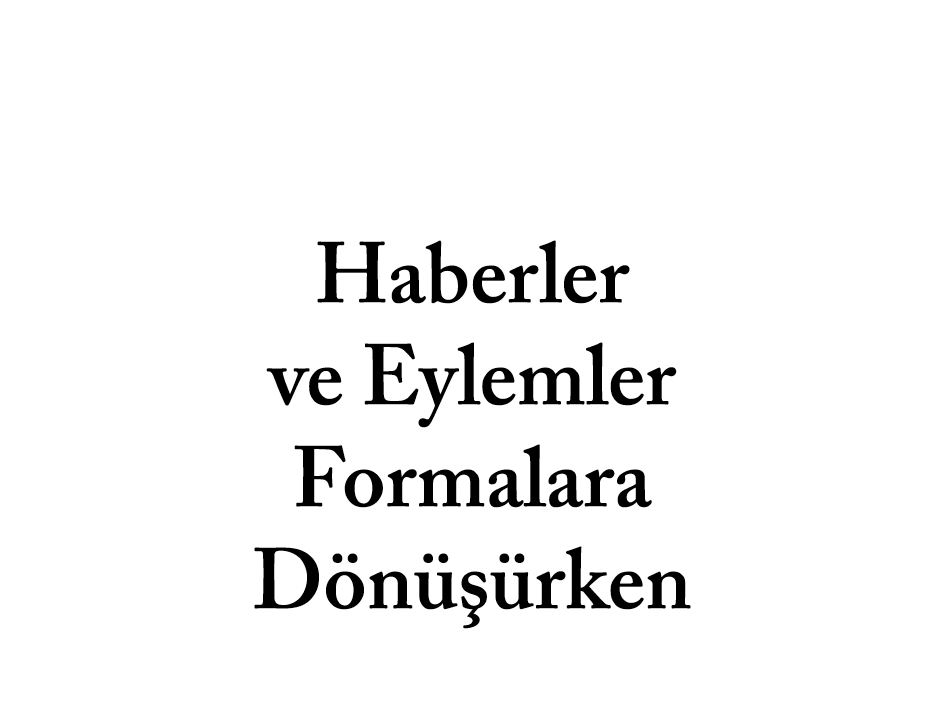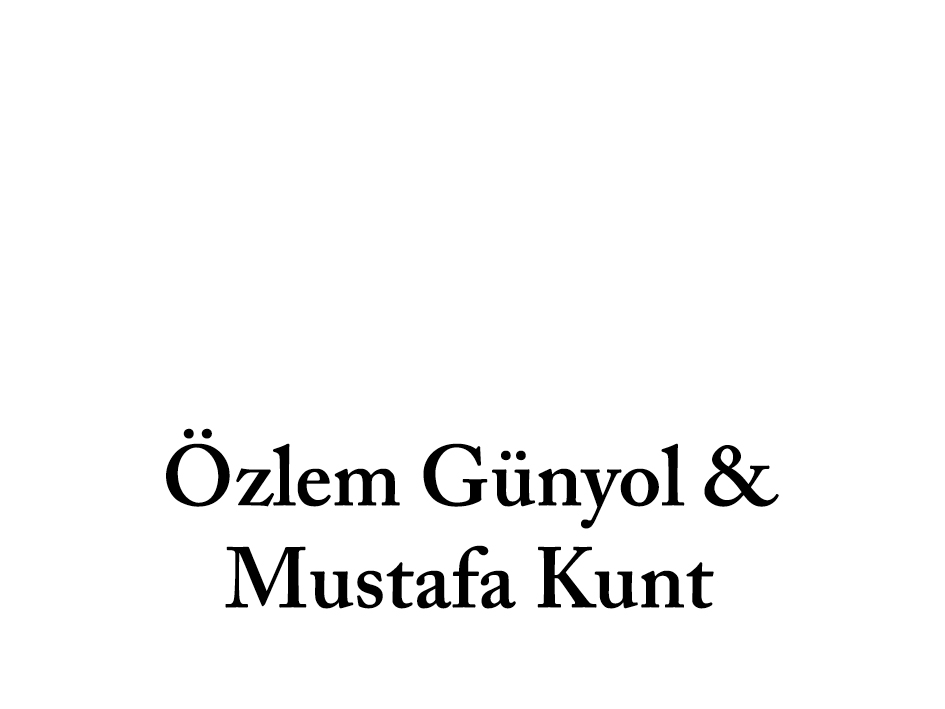Die Kraft des ästhetischen Objekts im Kontext abstrakter
Machtprozesse – Über die künstlerische Praxis von
Özlem Günyol und Mustafa Kunt
Um sich der heterogenen künstlerischen Praxis von Özlem Günyol und Mustafa Kunt anzunähern, erscheint es hilfreich, sich weniger an formalen Modellen einer Werkproduktion zu orientieren, als vielmehr die sozialen und kulturellen Kontexte in den Blick zu nehmen, die ihre Kunst zum Gegenstand haben.
Als zentrales Thema ihrer gemeinsamen Arbeit erscheint die Auseinandersetzung mit medial vermittelten Bildern und Zeichensystemen sowie der Verknüpfung von sprachlichen und visuellen Erfahrungen. Wie diese auf die kollektive und individuelle Ausdifferenzierung von Identitäten einwirken, die durch kulturelle und soziale Rahmenbedingungen geformt und vermittelt werden, ist dabei eine ihrer Kunst inhärente Thematik.
Immer werden dabei auch Fragen der medialen Repräsentanz von Macht innerhalb der Subjektbildung berührt und in luzider, formal äußerst vielseitiger Arbeitsweise illustriert. Auch die Auseinandersetzung mit sprachlichen Vermittlungsformen im medialen Kontext wird immer wieder als zentrales Moment ihrer Kunst sichtbar, wobei es die innovative Praxis von Özlem Günyol und Mustafa Kunt schwierig macht, die jeweiligen Themengebiete klar voneinander zu trennen. Nicht zuletzt dadurch offenbart ihr Werk die Durchdringung und Abhängigkeit der Aspekte Medialität und Macht und deren Anbindung an das kulturelle, soziale und politische Verständnis von Identität in unseren heutigen gesellschaftlichen Formationen.
Neben der konzeptuellen Herangehensweise wird in ihren Arbeiten spürbar, wie sich das Alleinstellungsmerkmal der Kunst, die ästhetische Erfahrung, als zentraler Bezugspunkt offenbart. Die an komplexe soziale Fragestellungen anschließenden Arbeiten operieren auch in ihrer konzeptuellen Ausrichtung als herausforderndes ästhetisches Erlebnis.
Günyols und Kunts Schaffen zeigt sich als breit gefächertes sensuelles Feld und ermöglicht damit eine gesonderte Form des Zugriffs auf unsere Umwelt. Ersichtlich wird in ihren Arbeiten, wie formalästhetische Aspekte innerhalb der Arbeitsweise bedeutsam werden und zugleich eine kritische Auseinandersetzung mit gesellschaftlichen Themen aufgegriffen wird.
Eine der aktuellsten Arbeiten des Duos, Hemzemin von 2014, zeigt den wiederholten Umgang mit Symbolen staatlicher Herrschaft und nationaler Repräsentanz. Die Arbeit besteht aus der Transformation eines zwölf Meter hohen Fahnenmastes, der in einem professionellen Schmelzverfahren zu einer 1,5 x 1,5 Meter großen Bodenplatte gegossen wurde. Das begleitende Video zeigt den aufwändigen Prozess der Umformung, der das aufrecht stehende Zeichen nationaler Repräsentanz in eine begehbare Platte auf dem Bodenniveau des Fußwegs in der Dortmunder Innenstadt verwandelt. Als unscheinbarer Bestandteil des öffentlichen Raums wird dem Fahnenmast seine auratische Wirkung entzogen und befragt die Machtstrukturen, die der Fahnenmast als Träger eines staatlich motivierten Herrschaftsanspruches, etwa einer Nationalflagge, postuliert. Das ursprüngliche Objekt wird nun in Relation zum öffentlichen Raum radikal verändert und verweist zugleich auf einer weiteren Bedeutungsebene auf die Funktion des Kunstwerks im urbanen Raum, die für das Duo jenseits repräsentativer Logiken zu liegen scheint.
Im Verhältnis zur neo-avantgardistischen Skulptur im öffentlichen Raum, der ein Anspruch auf größtmögliche Sichtbarkeit zumeist eingeschrieben war, demokratisiert Hemzemin diese Geste nachhaltig. Nicht zuletzt weist der türkische Titel der Arbeit, der im Deutschen mit den Worten ‚eins mit dem Grund sein’ wiederzugeben ist, auf die Normierungs- und Disziplinierungsprozesse, kollektive wie individuelle, die der Funktion von Herrschaftssymbolen -wie etwa Nationalflaggen- zugrunde liegen. Günyols und Kunts Arbeit verweigert eine schnell lesbare Sichtbarkeit zugunsten eines spekulativen Momentes, der die Funktionsmechanismen nationaler Identitäten befragt und zum Schwingen bringt.
In der Arbeit Fresh like the first Day von 2011 rückt die Bedeutung sprachlicher Vermittlung für die Konstitution von Gemeinschaften und die Genese von Wertesystemen in den Mittelpunkt.
Die installative Arbeit besteht aus 53 schwarz eingebundenen Büchern, die in einem der Arbeit zugehörigen Lesebereich für die Besucher zur Ansicht und zum Blättern ausliegen. Jedes der Bücher trägt auf der Frontseite auf schwarzem Grund einen geprägten goldenen Buchstaben des türkischen Alphabetes beziehungsweise der Satzzeichen und Zahlen, die in der türkischen Verfassung von 1982 Verwendung finden. Jedes in der Verfassung verwendete Zeichen wird in einem der 53 Bücher isoliert von allen anderen an exakt der Position der Seite dargestellt, an der es im Gesamttext verortet ist. So entsteht ein durch Auslassungen und Leerstellen geprägtes Konvolut, das seltsam abstrakte Strukturen ausbildet.
Die Motivation zur Entwicklung der Arbeit speist sich aus der jahrelangen Debatte über umfassende Änderungen der 1982 durch die Militärregierung verabschiedeten türkischen Verfassung, die durch eine Volksabstimmung 2010, bei der die Mehrheit der türkischen Bevölkerung für die von der regierenden Partei vorgeschlagenen Änderungen stimmte, ein vorläufiges Ende fand.
Aus dem fortlaufenden Verfassungstext wird in Fresh like the first Day in einem Prozess der Dekonstruktion ein auf 53 Bände differenzierter Index von Zeichen, die in ihrer Gesamtheit einen die türkische Gesellschaft konstituierenden Wert beinhalten. Durch diesen Akt der Zergliederung eröffnet sich ein Denk- und Assoziationsraum, der die Bedeutung von Zeichen und deren Funktion als gesellschaftskonstituierendes Moment hinterfragt. Der isolierte Buchstabe verliert seinen Bedeutungsgehalt, wird er nicht in einen Kontext unterschiedlichster differierender Zeichensysteme integriert.
Der in den Arbeiten Özlem Günyols und Mustafa Kunts offensichtliche Einsatz metaphorischer Aspekte, die dabei alle naiven Vergleichbarkeiten umgehen, zeigt sich, so scheint es, in den Leerstellen und Lücken, die der vermeintliche Text in den einzelnen Bänden von Fresh like the first Day aufweist. Die Installation regt ein bildhaftes Nachdenken über die Faktoren an, die Gemeinschaft konstituieren. Sind es die fest gefügten Systeme, ein Text, der dies ermöglicht, oder ist es das Zusammenspiel von Individuum und Kollektiv, das die zu definierenden offenen Räume in Bewegung bringt, um Teilhabe und Gemeinschaft zu ermöglichen?
Die Arbeit … and Justice for all! aus dem Jahr 2010 besteht aus einem 22 Meter langen, im Durchmesser etwa fünf Zentimeter starkem Seil, das gleichmäßig ausgeleuchtet auf einem Sockel akkurat zu einem lockeren Kreis zusammengerollt ist. Die Präzision, mit der das Seil gearbeitet wurde, wird durch die straffe Drillung und die exakt geknoteten und fixierten Enden auch für den Laien sichtbar. Diese augenscheinlich fachmännische Technik der Herstellung steht zu dem Material, das eher an poveres Leinen oder gewebte Stoffe erinnert, in einem gewissen Spannungsverhältnis.
Vermeintlich wird hier ein Seil als Kunst im Sinne eines Readymades vorgestellt, doch es bleiben Zweifel, ob dieses Seil tatsächlich einem funktionalen Gebrauchszweck entfremdet wurde – zu weich wirkt das Material, das unter der Bearbeitung des Streckens und Drehens sichtbar an Grenzpunkte seiner Belastbarkeit geführt wurde. Zudem zeichnen sich innerhalb des gedrillten Stoffes intensive grüne, gelbe, rote, orange und blaue Farbfelder ab, welche die Beige- und Ockertöne des restlichen Materials rhythmisieren.
Die weiterführende Auseinandersetzung mit dem Objekt verstärkt die Zweifel an der ausschließlich an einer Funktionalität orientierten Existenz des Seils, da eine kurze Erläuterung darüber aufklärt, dass das Seil ursprünglich aus einem Protestbanner entstanden ist, das den titelgebenden Schriftzug … and Justice for all! trug. Deutlich wird hierbei die Zielsetzung, jenseits der Herstellung eines Seiles eine Irritation zu inszenieren, die auf der Veränderung der Materialeigenschaften, also der Verarbeitung eines Stoffbanners zu einem Seil, beruht. Zunächst verweist die Transformation eines Banners zu einem Seil auf einen Prozess, der als Verfremdung des ursprünglichen Funktionszusammenhangs zu verstehen ist und diesen damit entwertet. Zugleich wird das Objekt nun in einem neuen Bedeutungsfeld verortet.
Diente das Banner der Vermittlung einer politischen Botschaft oder sozialen Forderung, die in der Öffentlichkeit zur Sprache gebracht wurde, so zeigt sich das Seil nun im Kunstkontext als ein Objekt, das eine kritische Denkbewegung anzustoßen in der Lage ist. Es scheint, als vollziehe sich die Anschlussfähigkeit der Arbeit an gesellschaftliche Fragestellungen, die den reinen Objektcharakter des Werkes hinter sich lassen, anhand einer nun assoziativen Lesbarkeit des Seils, das nun auch als Strick gedeutet werden kann und damit wiederum Fragen nach den Mechanismen von Gerechtigkeit und den dahinter stehenden Machtbeziehungen evoziert. Kann das Seil als funktionales Zeichen des Zusammenhaltes gesellschaftlicher Gruppen verstanden werden? Ist das Seil, als ein Bild für Vernetzungen, also Kommunikation, zu verstehen, das Verbindungen, sozialen Austausch und Zugehörigkeit generieren kann? Und wird nicht anhand des Transformationsprozesses von einem Banner zu einem Seil die Denkbewegung einer textuellen Annäherung an soziale Fragen hin zu einer metaphorischen und damit universalen, nicht-sprachlichen Aussageebene vorgeführt?
Eine weitere Arbeit, die sich mit den Repräsentationsmechanismen staatlicher Macht auseinandersetzt, ist Flag-s von 2009. Das auf Nesselstoff ausgeführte Werk zeigt eine schwarze rechteckige Fläche, deren Korona durch verschiedene Farben und einen Blauschimmer gebildet wird. Grundlage der Arbeit ist ein Druckverfahren, das die Nationalflaggen aller anerkannten 246 Länder der Erde übereinander druckt und als Resultat eine abstrakte schwarze Fläche generiert. Die vielfältigen Zeichen staatlicher Repräsentanz, die die Flaggen zu transportieren versuchen, werden durch die Überlagerung nur als abstraktes Bild sichtbar. Das Repräsentationszeichen entwertet sich dabei im Prozess der Überlagerung selbst. Auch hier wird das Kunstobjekt zum Ausgangspunkt einer Reflexion über die Kraft der repräsentativen Macht- und Zugehörigkeitsmodelle, die Gemeinschaften prägen und für diese stehen.
Augenfällig erscheint an den Arbeiten von Özlem Günyol und Mustafa Kunt der bewusst thematisierte Bezug zum sensuellen Objektcharakter ihrer Werke, der als Grundlage der beiden zentralen inhaltlichen Schwerpunkte deutlich wird. Zum einen die gezielte Inszenierung der materialästhetischen Qualität, die in den Arbeiten hervor tritt. Zum anderen die Anbindung dieses Aspekts an Fragen der kollektiven Identitätsbildung und den ihr zugrunde liegenden Normierungsprozessen. Durch die Betonung des Objektcharakters wird es möglich, die vielfach abstrakt wirkende Befragung der Themen Macht und Disziplinierung bildnerisch greifbar zu machen und an ein Objekt rückzukoppeln. Die Materialität des Objekts ermöglicht eine ästhetische Auseinandersetzung, die immer an eine kritische Verhandlung von Begriffen wie Identität und Norm, Macht und Gewalt und deren oftmals physisch nicht greifbare Wirkungsweise gebunden bleibt.
Gerade im Kontext gegenwärtiger Diskussionen um die gesellschaftliche Funktion der Kunst, verorten sich die Arbeiten von Özlem Günyol und Mustafa Kunt hellsichtig als Zwischenposition einer engagierten, explizit gesellschaftskritischen Kunst und dem Bestreben, kreativen Artikulationen einen autonomen Erfahrungsbereich jenseits funktionaler, sozialer Fragen zuzugestehen. Gegenüber einer voreiligen Zuordnung ihrer Kunst zu einer politischen Ausrichtung, optieren die Arbeiten zugunsten eines Regimes der Sichtbarkeit, die Jacques Rancière als Grundlage politischer und auch künstlerischer Handlungsfelder positionieren würde.*
Das Künstlerduo setzt sich im Kontext ihrer kritischen künstlerischen Bezugnahme mit einer unmittelbar erlebten Differenz unterschiedlicher Modelle des individuellen und kollektiven Identitätsverständnisses und dessen medialer Vermittlung auseinander. Das Nachdenken darüber, welche abstrakten und bildlich kaum fixierbaren Konstruktionsmechanismen über kulturell und historisch geprägte Disziplinierungsinstanzen in verschiedenen Kulturen und Wertesystemen auf das Individuum einwirken, bildet den Ausgangspunkt ihrer luziden künstlerischen Tätigkeit, die gesamtgesellschaftliche Aussagen über unsere Gegenwart zu artikulieren versteht, ohne die Eigenwertigkeit der ästhetischen Erfahrung als produktives Erfahrungsmodell zu negieren.
Felix Ruhöfer
*Jacques Rancière: Die Aufteilung des Sinnlichen; Berlin 2006









